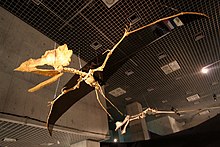Ornithocheiroidea
| Ornithocheiroids | |
|---|---|

| |
| Restored skeleton of Thalassodromeus sethi, with Anhanguera behind | |

| |
| Skeletal cast of Tropeognathus mesembrinus in the National Museum of Brazil | |
| Scientific classification | |
| Domain: | Eukaryota |
| Kingdom: | Animalia |
| Phylum: | Chordata |
| Order: | †Pterosauria |
| Suborder: | †Pterodactyloidea |
| Infraorder: | †Eupterodactyloidea |
| Clade: | †Ornithocheiroidea Seeley, 1870 |
| Subgroups | |
Ornithocheiroidea is a group of pterosaurs within the extinct suborder Pterodactyloidea. They were typically large pterosaurs that lived from the Early to Late Cretaceous periods (Valanginian to Maastrichtian stages), with fossil remains found all over the world except Antarctica.
Ornithocheiroids were the most advanced group of pterosaurs, as the group includes the clade Azhdarchoidea, of which its members lived until the Maastrichtian stage of the Late Cretaceous, around 66 million years ago. Notable pterosaurs from this group include the pteranodontians Pteranodon and Nyctosaurus, the ornithocheirids Ornithocheirus and Tropeognathus, as well as the azhdarchids Hatzegopteryx and Quetzalcoatlus.
Classification
The name Ornithocheiroidea was originally defined as an apomorphy-based taxon by Christopher Bennett in 1994. It was given a relationship-based definition in 2003 by Alexander Kellner, who defined it as the least inclusive clade containing Anhanguera blittersdorffi, Pteranodon longiceps, Dsungaripterus weii, and Quetzalcoatlus northropi.[2] Later that year, David Unwin suggested a more restrictive definition, in which the clade only contains Pteranodon longiceps, Istiodactylus latidens, and their descentants.[3] Brian Andres (2008, 2010, 2014) in his analyses, defined Ornithocheiroidea using the definition of Kellner (2003) to avoid confusion with similarly-defined groups, like Pteranodontoidea.[4]
Below is a cladogram showing the results of a phylogenetic analysis presented by Longrich, Martill, and Andres, 2018.[5]
References
- ^ Unwin, David M.; Heinrich, Wolf-Dieter (1999). "On a pterosaur jaw from the Upper Jurassic of Tendaguru (Tanzania)". Mitteilungen aus dem Museum für Naturkunde in Berlin, Geowissenschaftliche Reihe. 2: 121–134.
- ^ Kellner, A. W. A., (2003): Pterosaur phylogeny and comments on the evolutionary history of the group. pp. 105-137. — in Buffetaut, E. & Mazin, J.-M., (eds.): Evolution and Palaeobiology of Pterosaurs. Geological Society of London, Special Publications 217, London, 1-347
- ^ Unwin, D. M., (2003): On the phylogeny and evolutionary history of pterosaurs. pp. 139-190. — in Buffetaut, E. & Mazin, J.-M., (eds.): Evolution and Palaeobiology of Pterosaurs. Geological Society of London, Special Publications 217, London, 1-347 doi:10.1144/GSL.SP.2003.217.01.11
- ^ Andres, Brian Blake (2014). Systematics of the Pterosauria. Yale University. p. 366. A preview that shows the cladogram without clade names
- ^ Longrich, N.R., Martill, D.M., and Andres, B. (2018). Late Maastrichtian pterosaurs from North Africa and mass extinction of Pterosauria at the Cretaceous-Paleogene boundary. PLoS Biology, 16(3): e2001663. doi:10.1371/journal.pbio.2001663













